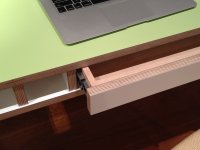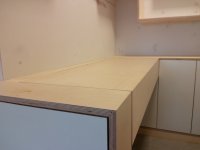Big Taco
Member
- Joined
- Jul 12, 2018
- Messages
- 11
What is the best process to create cabinet drawer fronts and doors using laminated Birch plywood? Edges will remain exposed.
Can I laminate an entire sheet of 4'x8' Birch plywood, edge the sides with a router, then use TS 55 to cut the drawer fronts and doors to the sizes I need or do I need to cut the plywood down to each individual drawer front and door and then laminate each piece and route each edge?
Can I get a clean cut of laminated plywood using the TS 55? What blade would be recommended?
Thanks,
Can I laminate an entire sheet of 4'x8' Birch plywood, edge the sides with a router, then use TS 55 to cut the drawer fronts and doors to the sizes I need or do I need to cut the plywood down to each individual drawer front and door and then laminate each piece and route each edge?
Can I get a clean cut of laminated plywood using the TS 55? What blade would be recommended?
Thanks,


